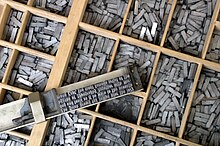Woodblock printing is a technique for printing text, images or patterns that was used widely throughout East Asia. It originated in China in antiquity as a method of printing on textiles and later on paper. As a method of printing on cloth, the earliest surviving examples from China date to before 220 AD, and from Roman Egypt to the 4th century.
The earliest surviving woodblock printed fragments are from China and are of silk printed with flowers in three colours from the Han dynasty (before 220 AD), and the earliest example of woodblock printing on paper appeared in the mid-7th century in China.
In Middle East
Woodblock printing on cloth appeared in Roman Egypt by the 4th century. Block printing, called tarsh in Arabic was developed in Arabic Egypt during the 9th-10th centuries, mostly for prayers and amulets. There is some evidence to suggest that the print blocks were made from a variety of different materials besides wood, including metals such as tin, lead and cast iron, as well as stone, glass and clay. However, the techniques employed are uncertain and they appear to have had very little influence outside of the Muslim world. Though Europe adopted woodblock printing from the Muslim world, initially for fabric, the technique of metal block printing remained unknown in Europe. Block printing later went out of use in Islamic Central Asia after movable type printing was introduced from China.[1]
[edit] In Europe
Block printing first came to Christian Europe as a method for printing on cloth, where it was common by 1300. Images printed on cloth for religious purposes could be quite large and elaborate, and when paper became relatively easily available, around 1400, the medium transferred very quickly to small woodcut religious images and playing cards printed on paper. These prints were produced in very large numbers from about 1425 onwards.
Around the mid-century, block-books, woodcut books with both text and images, usually carved in the same block, emerged as a cheaper alternative to manuscripts and books printed with movable type. These were all short heavily illustrated works, the bestsellers of the day, repeated in many different block-book versions: the Ars moriendi and the Biblia pauperum were the most common. There is still some controversy among scholars as to whether their introduction preceded or, the majority view, followed the introduction of movable type, with the range of estimated dates being between about 1440 and 1460.[2]
Movable type printing

Movable type is the system of printing and typography using movable pieces of metal type, made by casting from matrices struck by letterpunches. Movable type allowed for much more flexible processes than hand copying or block printing.
Around 1040, the first known movable type system was created in China by Bi Sheng out of porcelain.[3] Sheng used clay type, which broke easily, but Wang Zhen later carved a more durable type from wood by 1298 CE, and developed a complex system of revolving tables and number-association with written Chinese characters that made typesetting and printing more efficient. However, the main method in use there remained woodblock printing.
But around 1230, Korea first invented a metal type movable printing. The Jikji, published in 1377, is the earliest known metal printed book.
Around 1450, Johannes Gutenberg introduced what is regarded as an invention of movable type in Europe (see printing press), along with innovations in casting the type based on a matrix and hand mould. Gutenberg was the first to create his type pieces from an alloy of lead, tin and antimony – the same components still used today.[4]
Johannes Gutenberg's work on the printing press began in approximately 1436 when he partnered with Andreas Dritzehen — a man he had previously instructed in gem-cutting—and Andreas Heilmann, owner of a paper mill.[5] It was not until a 1439 lawsuit against Gutenberg that official record exists; witnesses testimony discussed type, an inventory of metals (including lead) and his type mold.[5]
Compared to woodblock printing, movable type page setting was faster and more durable. The metal type pieces were sturdier and the lettering more uniform, leading to typography and fonts. The high quality and relatively low price of the Gutenberg Bible (1455) established the superiority of movable type, and printing presses rapidly spread across Europe, leading up to the Renaissance, and later all around the world. Today, practically all movable type printing ultimately derives from Gutenberg's movable type printing, which is often regarded as the most important invention of the second millennium.[6]





